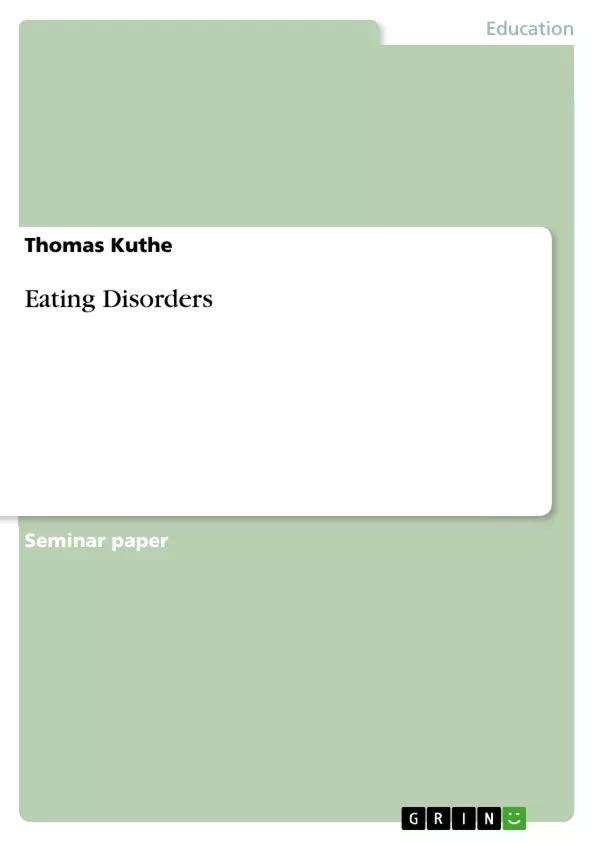Not much is known about how many men and women are suffering from eating disorders. However careful estimations are suggesting that about one percent of the girls aged between 12 and 20 are suffering from anorexia nervosa and about 3,5 percent of the 15 to 35 year old females from bulimia nervosa. Approximately 20 percent of the women up to 35 years of age are overweight, how many of these are suffering from an eating disorder remains unknown. Also young men are affected more and more. About 1,1 percent of the men aged between 14 and 24 have suffered from an eating disorder (Barmer).
An eating disorder is a serious illness. In this essay I would like to give a short overview over the main types of eating disorders, what disorders are, how they develop and what can be done to help sufferers. Additionally I would like to discuss a little study about eating habits and the effects done by an American college student.
Inhaltsverzeichnis (Table of Contents)
- Introduction
- What is an eating disorder?
- Who gets an eating disorder?
- Several kinds of eating disorders..
- Anorexia nervosa
- Bulimia nervosa.
- Binge eating/ Compulsive overeating....
- Treatment
- Snack time before and after meals: A habit that can lead to eating disorders.
- Literature
Zielsetzung und Themenschwerpunkte (Objectives and Key Themes)
This essay provides an overview of eating disorders, exploring their characteristics, causes, and treatment options. It examines the different types of eating disorders, their psychological and physiological aspects, and the factors that contribute to their development.
- The nature and impact of eating disorders
- The various types of eating disorders and their defining characteristics
- The role of societal pressures, media, and family dynamics in the development of eating disorders
- The importance of recognizing and addressing the psychological and emotional aspects of eating disorders
- The impact of eating habits and their connection to the development of eating disorders
Zusammenfassung der Kapitel (Chapter Summaries)
- Introduction: The introductory chapter discusses the prevalence of eating disorders, particularly among young women. It emphasizes the seriousness of these illnesses and outlines the essay's objective to provide a comprehensive understanding of eating disorders, including their development, treatment, and associated factors.
- What is an eating disorder?: This section defines eating disorders as disturbed eating behaviors. It clarifies that "normal" eating involves regulating food intake based on appetite, hunger, and satiety, ensuring adequate nutrient intake for the body. It also highlights the psychological distress underlying eating disorders and the use of eating or not eating as a coping mechanism for difficult emotions.
- Who gets an eating disorder?: This chapter explores the demographic groups most susceptible to eating disorders, focusing on young women, particularly those aged 15 to 25. It examines potential triggers for these disorders, including traumatic experiences, family problems, and other medical conditions. Additionally, it discusses the role of social and environmental factors, including the influence of media and societal pressures on body image.
- Several kinds of eating disorders: This chapter delves into the different types of eating disorders, highlighting the commonality of mental fixation and body rejection among sufferers while acknowledging variations in body weight and eating habits. It specifically addresses anorexia nervosa, emphasizing the misconception of "loss of appetite" and focusing on the individual's inability to satisfy their appetite due to self-imposed restrictions.
Schlüsselwörter (Keywords)
The primary focus of this text is on the nature, types, and causes of eating disorders. Key themes include the influence of societal pressures, body image, psychological distress, and family dynamics on the development of these disorders. The essay also explores the importance of healthy eating habits, emotional well-being, and appropriate treatment for individuals struggling with eating disorders.
- Quote paper
- Thomas Kuthe (Author), 2002, Eating Disorders, Munich, GRIN Verlag, https://www.grin.com/document/12894



